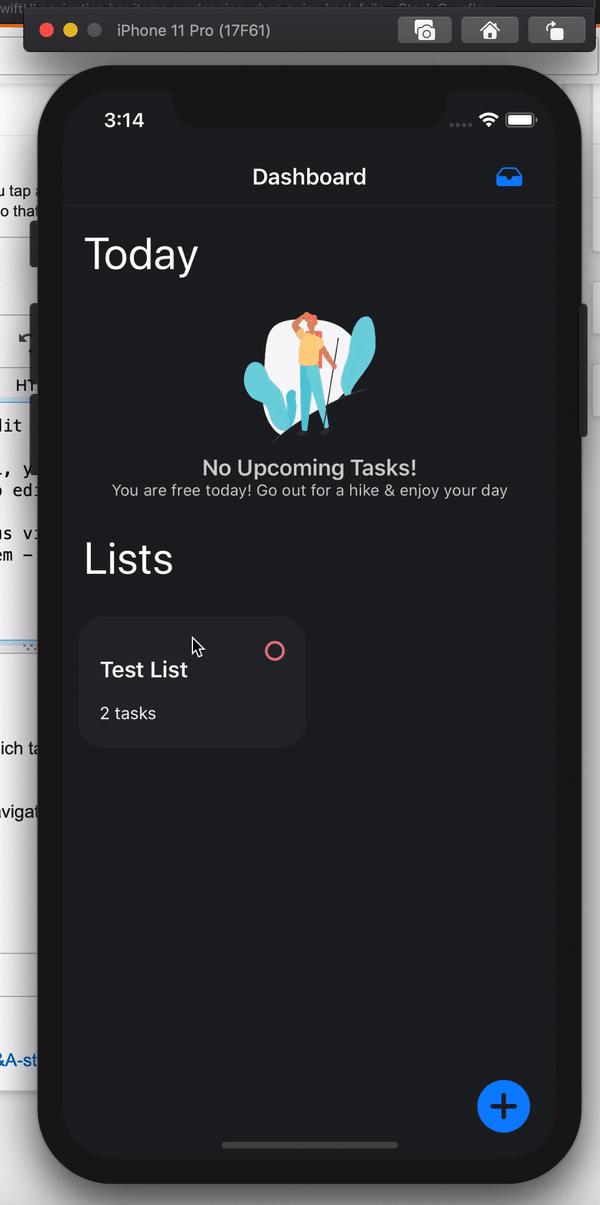I have a ListView, TasksView and then EditView.
The flow goes like this: you have a list cell, you tap that which takes you to TasksView When a row is tapped in TasksView it takes you to EditView.
When I half swipe back to navigate to previous view the navigation bar go bezerk and overlaps. It happens mainly if I use a navigationBarItem - (button).
In TasksView (detailView) there is a list and some navigation bar modifiers:
ZStack {
List {
// code here
}
}
.onAppear { UITableView.appearance().separatorStyle = .none }
.onDisappear { UITableView.appearance().separatorStyle = .none }
.background(Color("primaryBackground"))
.edgesIgnoringSafeArea(.bottom)
.navigationBarTitle("\(listItem.name ?? "")", displayMode: .inline)
.navigationBarItems(trailing:
Button(action: {self.deleteList()}) {
Image(systemName: "trash.circle.fill")
}
)
Same can be said for EditView, that when you half swipe on EditView to get back to TasksView, the same thing happens.
Here is the bug in action:
Anyone got any idea how to go about fixing this error?
EDIT:
struct TasksView: View {
@Environment(\.presentationMode) var presentationMode
@EnvironmentObject var taskControl: TaskControl
@EnvironmentObject var addNewTaskData: AddNewTaskViewDataFlow
@ObservedObject var dataPickerData : DatePickerDataFlowV2
@FetchRequest(entity: ONList.entity(), sortDescriptors: []) var listsDataSource: FetchedResults<ONList>
@Environment(\.managedObjectContext) var listMOC
var listItem: ONList
var keyboardPublisher: AnyCancellable
// defining the presentationMode here
.......
ZStack {
NavigationLink(destination: ListOptions(listItem: listItem), tag: 1, selection: self.$navigationSelectionTag) {
EmptyView()
}
Color("primaryBackground")
.edgesIgnoringSafeArea(.top)
//... more code here
}
.onAppear {
UITableView.appearance().separatorStyle = .none
self.taskControl.taskViewerSeperator = true
}
.onDisappear {
UITableView.appearance().separatorStyle = .none
print("Bye Task View")
if UIDevice.current.userInterfaceIdiom == .phone {
self.taskControl.taskViewerSeperator = false
}
self.keyboardPublisher.cancel()
}
.navigationBarTitle("\(listItem.name ?? "")", displayMode: .inline)
.background(Color("primaryBackground"))
.edgesIgnoringSafeArea(.bottom)
.navigationBarItems(trailing:
HStack {
Button(action: {
self.navigationSelectionTag = 1
}, label: {
Image(systemName: "gear")
})
Button(action: {
self.deleteList()
}) {
Image(systemName: "trash.circle.fill")
}.padding()
}
)
I am not even using the presentationMode in the deleteList() function in order to dismiss the current view when it gets deleted. However, I am still getting the same glitch as shown in the gif above.
UPDATE:
struct TestingCoreData: View {
var body: some View {
NavigationView {
VStack {
NavigationLink(destination: DestinationView()) {
Text("This is a test")
}
}.navigationBarTitle(Text("Master"), displayMode: .inline)
.navigationBarItems(trailing:
Button(action: {
print("tapped")
}) {
Text("Button")
}
)
}
}
}
struct DestinationView: View {
@Environment(\.presentationMode) var presentationMode
var body: some View {
List {
Text("DestinationView")
.padding(.top, 100)
.navigationBarTitle(Text("Destination"), displayMode: .inline)
.navigationBarItems(trailing: Button(action: {
self.presentationMode.wrappedValue.dismiss()
}, label: {
Text("second")
}))
}
}
}
The code above reproduces the bug. Where when you click "This is a test" button and then you swipe back a bit, and then go back to the last View, you will see the navigation bar going haywire!

